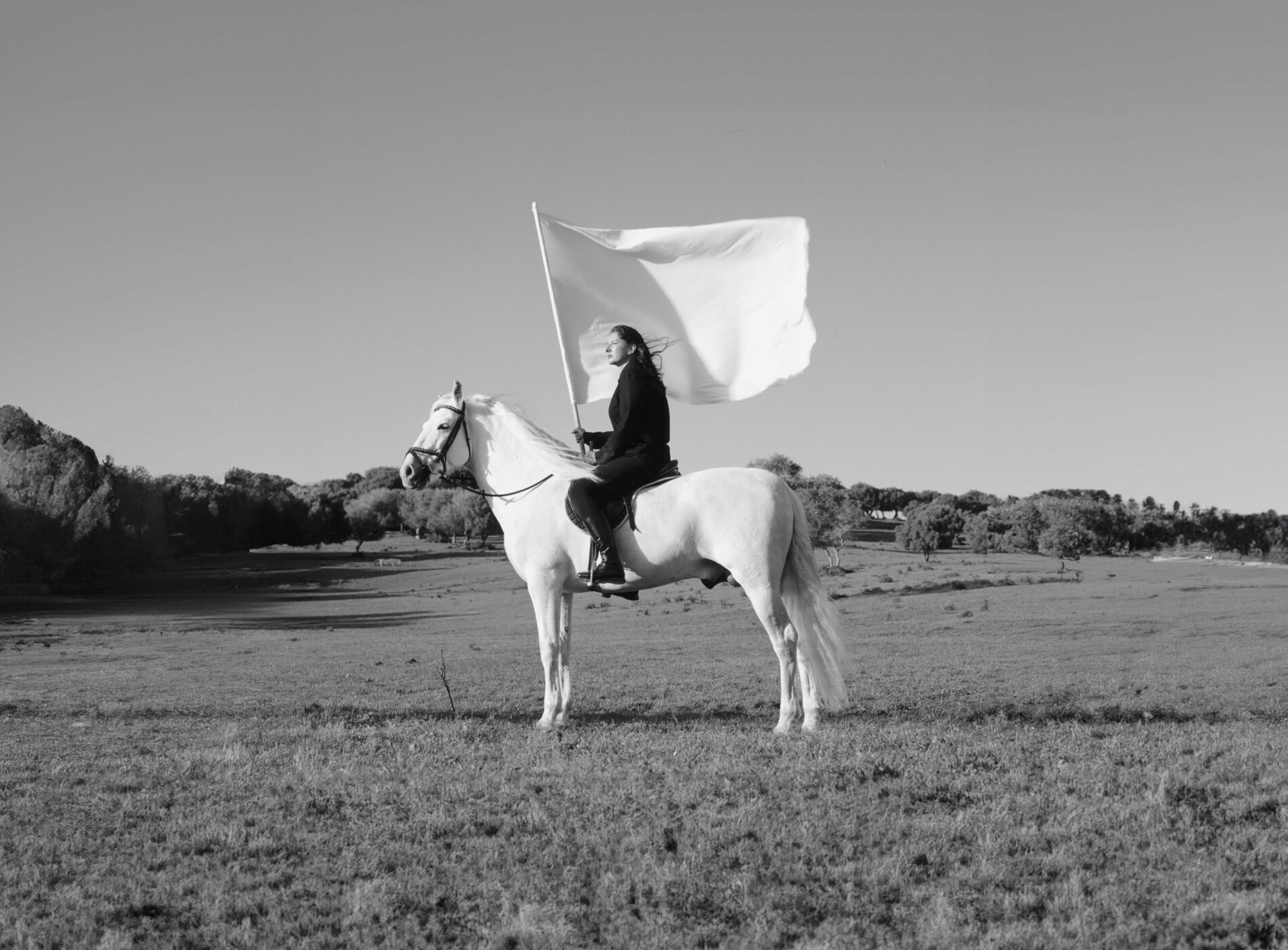

German High-Wire Performer Karl Wallenda, Age 71, Crosses The Thames River, London, 1976. Photo: Getty Images.
[](https://flaunt-mag.squarespace.com/config/pages/587fe9d4d2b857e5d49ca782#)[](https://flaunt-mag.squarespace.com/config/pages/587fe9d4d2b857e5d49ca782#)
Column: Arts
The Void Between Two Points
Watching a high-wire artist is not unlike being in an airplane during take-off. Gravity pastes your spine to your seat, while weightlessness rolls unbuckled around your belted waist. Your genitals–not your navel–seem to ground your body as gravity battles ascension. You might cry, confess undying love for the stranger beside you, or look for the nearest exit. You might close your window shade and then reopen it because you cannot tear your eyes away. It is terrifying and exhilarating all at once.
This gut reaction is more than curiosity or admiration. Think of art galleries: They’re full of somber people who are neither white-knuckled from gripping their seats nor faint from holding their breath in suspense. The Rothkos and Twomblys of the world are exquisite and complex, yet they rarely draw vast crowds. And while the silver screen is more successful at extracting a reaction from an audience, the suspension of disbelief can only hold so much weight. We can’t forget that movies aren’t true. Characters die; actors don’t. They aren’t real. But the man on the wire is real. He is taking real steps. His story unrolls as if on a thin reel of film, in real time, before eager eyes.
Some works of art manipulate and provoke; others allude and evoke. Tightrope walking does both. Everyone experiences vertigo watching a walker, but the walker himself is out to conquer vertigo. He must trust the wire without trusting the wire, trust himself without trusting himself, take himself beyond what is usually possible without going beyond his ability. He must defy gravity by obeying it. He must love the void between two points, more than he loves the wire that connects them.
After Philippe Petit walked between the two towers of the World Trade Center on a high-wire he said, “When I see three oranges, I juggle; when I see two towers, I walk.” Sensationalism surrounding the French acrobat’s performance would tiptoe in later, but on that Wednesday morning in 1974, it was simply about his dance across the rope.
“Le coup,” as Petit called his feat, is chronicled from conception to execution in James Marsh’s Oscar-winning documentary Man on Wire. Petit, and the people who ended up following him in his colossal project, engaged in plans, espionage, and fraud all worthy of an elaborate jewel heist as they sneaked in and out of the World Trade Center, passed themselves off as construction workers, journalists, and photographers to access the roof and eventually shot the massive, custom-made wire from one tower to the other with a bow and arrow.
From the beginning it is Petit’s dogged pursuit of his goal, not the bells and whistles surrounding it, that captures attention. (Imagine, if you can, the Bob Ross of high-wire walking and you will have a preliminary understanding of Petit’s enthusiasm.) His appreciation of the beauty in wires and balancing poles and soft, supple shoes woos you to crane your neck and look up. By the end, as footage of the act itself unrolls across the screen, you have donned those shoes. You wish for your own wire to walk.
A lot of people can juggle. Few people can cross a tightrope. Acrobats, contortionists, and even dancers are often considered athletes before they are considered artists, as if all artists begin as children who were picked last for sports teams. Yet the wire walker’s first step is like any other creative endeavor. He balances on his medium with the messianic sense that his steps won’t sink him. He believes he’ll make it to the other side despite any conflicts or climaxes along the way. Whether they work in words or oil paints, all artists share this stubborn, primordial belief, perhaps not as much in slips and slides across taut truth but definitely in crossed-out sentences and slashed canvases.
Legend has it that a tenth-century monk, Guido of Arezzo, first thought of a rhythmic notation for music while walking from one abbey to another in varying gaits. Henry David Thoreau wrote that “we should go forth on the shortest walk, perchance, in the spirit of undying adventure, never to return; prepared to send back our embalmed hearts only, as relics to our desolate kingdoms.” Solvitur ambulando: “It is solved by walking.” Wire walking eliminates the separation between thought and act, mind and matter. Wire walking erases the separation between artist and art, performance and performer.
A work of art gives body to thoughts and emotions, lets them loose in the yard to tumble and wrestle. When an artist gives his body to his art, it is the ultimate conduit of his passion. The wire walk is simultaneously the original idea, the artistic process, and the finished product. Bring to life a limerick or a landscape, but your work will never feel as sure or steady as the walker’s step back onto solid ground.
And if he falls?
In March of 1978, Karl Wallenda fell to his death from a high wire in San Juan, Puerto Rico, just four years after Philippe Petit’s walk over Manhattan. He was 73 years old. In the 1920s, Wallenda had orchestrated a circus stunt with his two brothers and a girl who would later become his wife; the group would expand over the years to include each new, similarly talented family member and in the 1940s came to be known as “The Flying Wallendas.” This dynasty eventually produced Nik Wallenda, whose funambulist jaunts have won several world records. Recently, the world watched as he crossed the Grand Canyon on a wire two inches thick.
It was Karl who taught his family not to trust safety nets, claiming that they offered a false sense of security. Over the years, the Wallendas continued to perform despite several family members injuring themselves or dying during stunts. While interest in circus acts has waned in the past few decades, Nik Wallenda claims that the industry “is not dying, it’s just changing.”
People may no longer pay to see garishly made-up clowns or freak shows, but Wallenda’s prediction is no doubt true, because in wire walking, there is always the possibility of death. Both Philippe Petit and Nik Wallenda scoff, in their separate ways, at people who ask them if they’ve ever fallen from the rope. But it’s a soft scoff. It is the secret and most often unconscious wish of every spectator that the high-wire artist will give his life for his art. A fall, or an almost-fall, would legitimize the act; make it more human. Like a nightmare that wakes you in the night, the slip or the tumble would serve as a reminder that there is no safe space, no matter how nimbly the walker seems to cross the wire. His attempt, nearly tragic, would become more respectable and raw in the eyes of those watching him. This near-walk would be like the Sagrada Familia cathedral or the Winchester Mansion—perpetually unfinished, absolutely mystifying, symbols of a time when people sought to reach the heights with greater madness than they do now.
An imbalanced idea will quiet a pen and lead a paintbrush astray, but it will knock over a wire walker. If he is victorious, his is not only a creative victory; it’s a con, a cheat against death. The writer and painter can hope to be immortalized in their art; the tightrope walker would be happy to simply come out of his alive.
 
German High-Wire Performer Karl Wallenda, Age 71, Crosses The Thames River, London, 1976. Photo: Getty Images.
[](https://flaunt-mag.squarespace.com/config/pages/587fe9d4d2b857e5d49ca782#)[](https://flaunt-mag.squarespace.com/config/pages/587fe9d4d2b857e5d49ca782#)
Column: Arts
The Void Between Two Points
Watching a high-wire artist is not unlike being in an airplane during take-off. Gravity pastes your spine to your seat, while weightlessness rolls unbuckled around your belted waist. Your genitals–not your navel–seem to ground your body as gravity battles ascension. You might cry, confess undying love for the stranger beside you, or look for the nearest exit. You might close your window shade and then reopen it because you cannot tear your eyes away. It is terrifying and exhilarating all at once.
This gut reaction is more than curiosity or admiration. Think of art galleries: They’re full of somber people who are neither white-knuckled from gripping their seats nor faint from holding their breath in suspense. The Rothkos and Twomblys of the world are exquisite and complex, yet they rarely draw vast crowds. And while the silver screen is more successful at extracting a reaction from an audience, the suspension of disbelief can only hold so much weight. We can’t forget that movies aren’t true. Characters die; actors don’t. They aren’t real. But the man on the wire is real. He is taking real steps. His story unrolls as if on a thin reel of film, in real time, before eager eyes.
Some works of art manipulate and provoke; others allude and evoke. Tightrope walking does both. Everyone experiences vertigo watching a walker, but the walker himself is out to conquer vertigo. He must trust the wire without trusting the wire, trust himself without trusting himself, take himself beyond what is usually possible without going beyond his ability. He must defy gravity by obeying it. He must love the void between two points, more than he loves the wire that connects them.
After Philippe Petit walked between the two towers of the World Trade Center on a high-wire he said, “When I see three oranges, I juggle; when I see two towers, I walk.” Sensationalism surrounding the French acrobat’s performance would tiptoe in later, but on that Wednesday morning in 1974, it was simply about his dance across the rope.
“Le coup,” as Petit called his feat, is chronicled from conception to execution in James Marsh’s Oscar-winning documentary Man on Wire. Petit, and the people who ended up following him in his colossal project, engaged in plans, espionage, and fraud all worthy of an elaborate jewel heist as they sneaked in and out of the World Trade Center, passed themselves off as construction workers, journalists, and photographers to access the roof and eventually shot the massive, custom-made wire from one tower to the other with a bow and arrow.
From the beginning it is Petit’s dogged pursuit of his goal, not the bells and whistles surrounding it, that captures attention. (Imagine, if you can, the Bob Ross of high-wire walking and you will have a preliminary understanding of Petit’s enthusiasm.) His appreciation of the beauty in wires and balancing poles and soft, supple shoes woos you to crane your neck and look up. By the end, as footage of the act itself unrolls across the screen, you have donned those shoes. You wish for your own wire to walk.
A lot of people can juggle. Few people can cross a tightrope. Acrobats, contortionists, and even dancers are often considered athletes before they are considered artists, as if all artists begin as children who were picked last for sports teams. Yet the wire walker’s first step is like any other creative endeavor. He balances on his medium with the messianic sense that his steps won’t sink him. He believes he’ll make it to the other side despite any conflicts or climaxes along the way. Whether they work in words or oil paints, all artists share this stubborn, primordial belief, perhaps not as much in slips and slides across taut truth but definitely in crossed-out sentences and slashed canvases.
Legend has it that a tenth-century monk, Guido of Arezzo, first thought of a rhythmic notation for music while walking from one abbey to another in varying gaits. Henry David Thoreau wrote that “we should go forth on the shortest walk, perchance, in the spirit of undying adventure, never to return; prepared to send back our embalmed hearts only, as relics to our desolate kingdoms.” Solvitur ambulando: “It is solved by walking.” Wire walking eliminates the separation between thought and act, mind and matter. Wire walking erases the separation between artist and art, performance and performer.
A work of art gives body to thoughts and emotions, lets them loose in the yard to tumble and wrestle. When an artist gives his body to his art, it is the ultimate conduit of his passion. The wire walk is simultaneously the original idea, the artistic process, and the finished product. Bring to life a limerick or a landscape, but your work will never feel as sure or steady as the walker’s step back onto solid ground.
And if he falls?
In March of 1978, Karl Wallenda fell to his death from a high wire in San Juan, Puerto Rico, just four years after Philippe Petit’s walk over Manhattan. He was 73 years old. In the 1920s, Wallenda had orchestrated a circus stunt with his two brothers and a girl who would later become his wife; the group would expand over the years to include each new, similarly talented family member and in the 1940s came to be known as “The Flying Wallendas.” This dynasty eventually produced Nik Wallenda, whose funambulist jaunts have won several world records. Recently, the world watched as he crossed the Grand Canyon on a wire two inches thick.
It was Karl who taught his family not to trust safety nets, claiming that they offered a false sense of security. Over the years, the Wallendas continued to perform despite several family members injuring themselves or dying during stunts. While interest in circus acts has waned in the past few decades, Nik Wallenda claims that the industry “is not dying, it’s just changing.”
People may no longer pay to see garishly made-up clowns or freak shows, but Wallenda’s prediction is no doubt true, because in wire walking, there is always the possibility of death. Both Philippe Petit and Nik Wallenda scoff, in their separate ways, at people who ask them if they’ve ever fallen from the rope. But it’s a soft scoff. It is the secret and most often unconscious wish of every spectator that the high-wire artist will give his life for his art. A fall, or an almost-fall, would legitimize the act; make it more human. Like a nightmare that wakes you in the night, the slip or the tumble would serve as a reminder that there is no safe space, no matter how nimbly the walker seems to cross the wire. His attempt, nearly tragic, would become more respectable and raw in the eyes of those watching him. This near-walk would be like the Sagrada Familia cathedral or the Winchester Mansion—perpetually unfinished, absolutely mystifying, symbols of a time when people sought to reach the heights with greater madness than they do now.
An imbalanced idea will quiet a pen and lead a paintbrush astray, but it will knock over a wire walker. If he is victorious, his is not only a creative victory; it’s a con, a cheat against death. The writer and painter can hope to be immortalized in their art; the tightrope walker would be happy to simply come out of his alive.

German High-Wire Performer Karl Wallenda, Age 71, Crosses The Thames River, London, 1976. Photo: Getty Images.
[](https://flaunt-mag.squarespace.com/config/pages/587fe9d4d2b857e5d49ca782#)[](https://flaunt-mag.squarespace.com/config/pages/587fe9d4d2b857e5d49ca782#)
Column: Arts
The Void Between Two Points
Watching a high-wire artist is not unlike being in an airplane during take-off. Gravity pastes your spine to your seat, while weightlessness rolls unbuckled around your belted waist. Your genitals–not your navel–seem to ground your body as gravity battles ascension. You might cry, confess undying love for the stranger beside you, or look for the nearest exit. You might close your window shade and then reopen it because you cannot tear your eyes away. It is terrifying and exhilarating all at once.
This gut reaction is more than curiosity or admiration. Think of art galleries: They’re full of somber people who are neither white-knuckled from gripping their seats nor faint from holding their breath in suspense. The Rothkos and Twomblys of the world are exquisite and complex, yet they rarely draw vast crowds. And while the silver screen is more successful at extracting a reaction from an audience, the suspension of disbelief can only hold so much weight. We can’t forget that movies aren’t true. Characters die; actors don’t. They aren’t real. But the man on the wire is real. He is taking real steps. His story unrolls as if on a thin reel of film, in real time, before eager eyes.
Some works of art manipulate and provoke; others allude and evoke. Tightrope walking does both. Everyone experiences vertigo watching a walker, but the walker himself is out to conquer vertigo. He must trust the wire without trusting the wire, trust himself without trusting himself, take himself beyond what is usually possible without going beyond his ability. He must defy gravity by obeying it. He must love the void between two points, more than he loves the wire that connects them.
After Philippe Petit walked between the two towers of the World Trade Center on a high-wire he said, “When I see three oranges, I juggle; when I see two towers, I walk.” Sensationalism surrounding the French acrobat’s performance would tiptoe in later, but on that Wednesday morning in 1974, it was simply about his dance across the rope.
“Le coup,” as Petit called his feat, is chronicled from conception to execution in James Marsh’s Oscar-winning documentary Man on Wire. Petit, and the people who ended up following him in his colossal project, engaged in plans, espionage, and fraud all worthy of an elaborate jewel heist as they sneaked in and out of the World Trade Center, passed themselves off as construction workers, journalists, and photographers to access the roof and eventually shot the massive, custom-made wire from one tower to the other with a bow and arrow.
From the beginning it is Petit’s dogged pursuit of his goal, not the bells and whistles surrounding it, that captures attention. (Imagine, if you can, the Bob Ross of high-wire walking and you will have a preliminary understanding of Petit’s enthusiasm.) His appreciation of the beauty in wires and balancing poles and soft, supple shoes woos you to crane your neck and look up. By the end, as footage of the act itself unrolls across the screen, you have donned those shoes. You wish for your own wire to walk.
A lot of people can juggle. Few people can cross a tightrope. Acrobats, contortionists, and even dancers are often considered athletes before they are considered artists, as if all artists begin as children who were picked last for sports teams. Yet the wire walker’s first step is like any other creative endeavor. He balances on his medium with the messianic sense that his steps won’t sink him. He believes he’ll make it to the other side despite any conflicts or climaxes along the way. Whether they work in words or oil paints, all artists share this stubborn, primordial belief, perhaps not as much in slips and slides across taut truth but definitely in crossed-out sentences and slashed canvases.
Legend has it that a tenth-century monk, Guido of Arezzo, first thought of a rhythmic notation for music while walking from one abbey to another in varying gaits. Henry David Thoreau wrote that “we should go forth on the shortest walk, perchance, in the spirit of undying adventure, never to return; prepared to send back our embalmed hearts only, as relics to our desolate kingdoms.” Solvitur ambulando: “It is solved by walking.” Wire walking eliminates the separation between thought and act, mind and matter. Wire walking erases the separation between artist and art, performance and performer.
A work of art gives body to thoughts and emotions, lets them loose in the yard to tumble and wrestle. When an artist gives his body to his art, it is the ultimate conduit of his passion. The wire walk is simultaneously the original idea, the artistic process, and the finished product. Bring to life a limerick or a landscape, but your work will never feel as sure or steady as the walker’s step back onto solid ground.
And if he falls?
In March of 1978, Karl Wallenda fell to his death from a high wire in San Juan, Puerto Rico, just four years after Philippe Petit’s walk over Manhattan. He was 73 years old. In the 1920s, Wallenda had orchestrated a circus stunt with his two brothers and a girl who would later become his wife; the group would expand over the years to include each new, similarly talented family member and in the 1940s came to be known as “The Flying Wallendas.” This dynasty eventually produced Nik Wallenda, whose funambulist jaunts have won several world records. Recently, the world watched as he crossed the Grand Canyon on a wire two inches thick.
It was Karl who taught his family not to trust safety nets, claiming that they offered a false sense of security. Over the years, the Wallendas continued to perform despite several family members injuring themselves or dying during stunts. While interest in circus acts has waned in the past few decades, Nik Wallenda claims that the industry “is not dying, it’s just changing.”
People may no longer pay to see garishly made-up clowns or freak shows, but Wallenda’s prediction is no doubt true, because in wire walking, there is always the possibility of death. Both Philippe Petit and Nik Wallenda scoff, in their separate ways, at people who ask them if they’ve ever fallen from the rope. But it’s a soft scoff. It is the secret and most often unconscious wish of every spectator that the high-wire artist will give his life for his art. A fall, or an almost-fall, would legitimize the act; make it more human. Like a nightmare that wakes you in the night, the slip or the tumble would serve as a reminder that there is no safe space, no matter how nimbly the walker seems to cross the wire. His attempt, nearly tragic, would become more respectable and raw in the eyes of those watching him. This near-walk would be like the Sagrada Familia cathedral or the Winchester Mansion—perpetually unfinished, absolutely mystifying, symbols of a time when people sought to reach the heights with greater madness than they do now.
An imbalanced idea will quiet a pen and lead a paintbrush astray, but it will knock over a wire walker. If he is victorious, his is not only a creative victory; it’s a con, a cheat against death. The writer and painter can hope to be immortalized in their art; the tightrope walker would be happy to simply come out of his alive.









.JPG)
.jpg)







